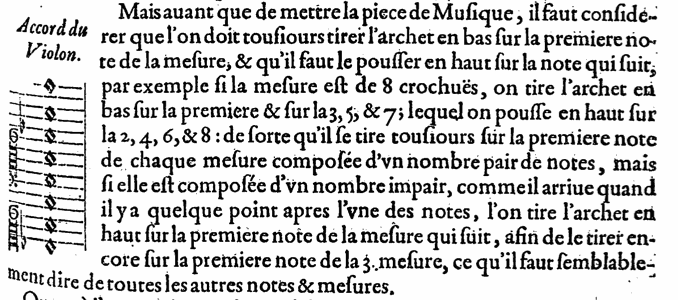A Timeline history of the Violin Bow - from c. 1600 - 1800
... the sources in detail ...
Marin Mersenne (1588 - 1648)
L'Harmonie Universelle (Paris 1636/7 )
(An online facsimile is available on imslp, here)
Mersenne is probably best known for his work on accoustics - he was a theologian who studied mathematics and music. The second part of his enormous L'Harmonie Universelle talks about the various instruments, the 7th book treating the string instruments. He particularly praises the violin for its "ravishing" tone, and its ability, having no frets, to play in any temperament, and in many different styles. About bowing in particular he writes:
"But before starting the piece of music, one must consider that one should always pull the bow down on the first note of the bar, and push it up on the following note, for example, if the bar has 8 quavers, one plays a down bow on the first, 3,5 and 7th, and an up bow on 2,4,6 and 8; one always plays like this on the first beat of every bar composed of an equal number of notes, but if it is composed of an uneven number, as happens if one of the notes is dotted, one pulls an up bow on the first note of the following bar, and then pulls [down] once more on the third bar - and so for all notes and bars".

This passage has, I fear, been misunderstood. Riley (The Teaching of bowed instruments, dissertation, 1954), for example, writes, "Mersenne maintains whether or not there is an even or an odd number of notes in the measure, the first note is always to be played with a down bow". Actually, I'm not sure that's what Mersenne means; - in fact his language is rather confusing; - first of all he writes "tirer en bas" ("pull down" = down bow), then "pousser en haut" ("push up" = up bow), and then, in the case of an uneven number of notes in the bar "tirer en haut" ("pull up" = ? - does he mean up or down bow?). It's quite possible that Mersenne is NOT advocating Lully bowing, (down on every bar-line - see Muffat) but expressing a tendency to start the first note of a piece with a down bow, and in bars with an uneven number of notes let the subsequent bar be on an up-bow - "as it comes", so to speak.